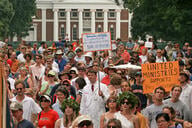You have /5 articles left.
Sign up for a free account or log in.
We are about to discover if pedagogical necessity becomes the mother of innovation. In a matter of a few weeks, due to COVID-19, many colleges and universities committed to completing their academic year via remote teaching and learning. Arguably, the group of faculty members most reticent to join this necessary move were those from national liberal arts colleges.
Where does their reluctance come from? To understand, it’s important to take a close look at the environment in which they are accustomed to teaching. Residential liberal arts colleges are intensive, immersive educational experiences literally grounded in a sense of place. Typically, 99 percent of students, at least in their early years, live on campus, and the office of student affairs stands as an educational partner with academic affairs. A beautiful, small-scale campus is the setting for the learning that takes place, often apart from metropolitan centers.
The experience is personalized. It is driven by the mentoring relationships of faculty members who teach students in small classes and of staff members who have the luxury of knowing not only students’ names, but also their talents, backgrounds and aspirations. And the occasional meal at a professor’s home is still a reality for many of these students. This is the narrative of these colleges at their best.
Such residential liberal arts institutions have tended to be the most skeptical of online learning, and for reasons consistent with their commitment to the on-campus, in-person experience they provide. When online education was equated with massive open online courses (so-called MOOCs), these faculty were right to point out that asynchronous lectures, along with sidebar learning activities and limited interaction with teaching assistants or discussion moderators, were no substitute for the individualized academic experiences of the immersive campus experience.
Top national liberal arts colleges thus have shied away from fully online courses. Many of them continue to limit (or in some cases prohibit) credit for courses that have an online mode of delivery.
At the same time, especially as the national infatuation with MOOCs waned, faculty members across the disciplines at liberal arts colleges have continued digital experimentation, including increased use of innovations such as flipped or inverted classrooms, asynchronous content on course learning platforms, and online discussion boards.
Enter COVID-19. With approximately six weeks left in the academic year, administrators quickly determined that finishing the year via remote teaching and learning was viable for meeting both pedagogical and practical objectives. In general terms, faculty shared the desire and the commitment to use the available technological means to complete their courses.
But for the faculty members on residential liberal arts campuses who have carved a niche in the higher education landscape by incorporating face-to-face interactions inside and beyond the classroom, this prospect has created more than a little consternation. In a sense, they now face the challenge of teaching via modes and methods that they have largely spurned. The urgency of the moment has not allowed for normal deliberation on what might be lost or gained in this transition.
The good news is that lessons learned from best practices in teaching and learning ameliorate this dilemma. First and perhaps most important, hybrid learning is preferable to fully online learning. For colleges on a typical semester calendar, students have completed over half of their semester through in-person classes. Faculty members know their current students, and vice versa. The groundwork of relationships to continue courses through online formats has been built. Except for those unfortunate seniors, other undergraduates will be able to return -- we all hope -- to campuses in the fall with an opportunity to follow up on their remote learning experiences, once again in person.
Second, the very context of crisis that requires teaching remotely also creates a giant window for pedagogical innovation -- and with a lower penalty for failure than in any normal circumstance. Administrators, like students and their parents, realize that faculty members did not want to move their courses online. Their ideal classroom went by the wayside with March Madness and a bullish stock market. Further, most higher education institutions are debating whether if at all to include student teaching and course assessments in professors’ evaluations for tenure or promotion, and how to use the pass-fail option in courses.
These factors will allow for more experimentation and creativity. For instance, faculty members will find new ways to assess learning outcomes beyond comprehensive exams, such as via online posters and presentations. Group projects will take on new forms. And, by necessity, discussion will take place asynchronously through discussion board and video responses.
Said a different way, this is a moment for pedagogical experimentation, especially for faculty members at residential liberal arts institutions where online teaching may be uncommon. That may sound like turning lemons into lemonade. Indeed, it is. That is often how meaningful innovation happens.








